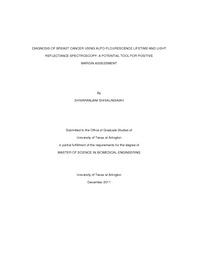
ATTENTION: The works hosted here are being migrated to a new repository that will consolidate resources, improve discoverability, and better show UTA's research impact on the global community. We will update authors as the migration progresses. Please see MavMatrix for more information.
Show simple item record
| dc.contributor.author | Shivalingaiah, Shivaranjani | en_US |
| dc.date.accessioned | 2012-04-11T20:55:35Z | |
| dc.date.available | 2012-04-11T20:55:35Z | |
| dc.date.issued | 2012-04-11 | |
| dc.date.submitted | January 2011 | en_US |
| dc.identifier.other | DISS-11544 | en_US |
| dc.identifier.uri | http://hdl.handle.net/10106/9553 | |
| dc.description.abstract | Malignant Breast Neoplasm (MBN) or breast cancer is a heterogeneous cancer type originating in the breast tissue. Surgery is considered the primary treatment for breast cancer, with many early stage patients being cured without recurrence. The goals of the surgery include complete resection of the primary tumor, with negative margins to reduce the risk of local recurrences. Further, pathological staging of the tumor and axillary lymph nodes are carried out to extract necessary prognostic information. Surgery works well in case of complete Mastectomies. However, the biggest challenge for this technique is determining adequate margins on the partial mastectomy (lumpectomy) specimen. In 30-50% of patients, positive margins are reported, resulting in additional surgery, leading to potential hazards like reduction in breast size, higher risk of wound infection and loss of confidence in the surgical procedure. Therefore, there exists a high demand for investigating into mechanisms that will potentially aid in reducing the rate of positive margins and thereby reducing the case for re-excision Optical techniques can play an important role in diagnostics, breast cancer evaluation and treatment. This thesis outlines the possibility of combining two powerful modalities and extracting parameters that offer better diagnosis and margin assessment. Clinical post-operative readings were obtained from excised breast samples, using by auto-fluorescence life-time measurement (AFLM) and the light reflectance spectroscopy (LRS). Specifically, Seven breast cancer specimen, histopathologicaly diagnosed as Invasive Ductal Carcinoma with no history of pre-surgical chemotherapy, were investigated using dual optical modalities to derive statistical differences between breast cancer (i.e. IDC) and normal breast tissue (i.e. ductal epithelium). The results demonstrate that both AFLM derived and LRS-derived parameters can serve as biomarkers in differentiating tumor from normal tissue in human breast. Specifically, spectral slopes at four wavelength regions in LRS have shown significant differences between cancer and normal tissues; a classification algorithm was further used to generate a receiver operating characteristic (ROC) curve determining the capability of LRS as a possible diagnostic tool for breast tissue for malignancy. | en_US |
| dc.description.sponsorship | Shivalingaiah, Shivaranjani | en_US |
| dc.language.iso | en | en_US |
| dc.publisher | Biomedical Engineering | en_US |
| dc.title | Diagnosis Of Breast Cancer Using Auto-flourescence Lifetime And Light Reflectance Spectroscopy: A Potential Tool For Positive Margin Assessment | en_US |
| dc.type | M.S. | en_US |
| dc.contributor.committeeChair | Shivalingaiah, Shivaranjani | en_US |
| dc.degree.department | Biomedical Engineering | en_US |
| dc.degree.discipline | Biomedical Engineering | en_US |
| dc.degree.grantor | University of Texas at Arlington | en_US |
| dc.degree.level | masters | en_US |
| dc.degree.name | M.S. | en_US |
Files in this item
- Name:
- Shivalingaiah_uta_2502M_11544.pdf
- Size:
- 1.535Mb
- Format:
- PDF
This item appears in the following Collection(s)
Show simple item record


